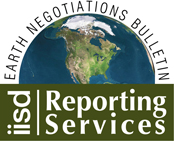 |
||
|
published by IISD, the International Institute for Sustainable Development
in cooperation with the CBD Secretariat |
|||
|
A Special Report on Selected Side Events at CBD COP-8
|
|||||
| 20-31 March 2006 | Curitiba, Brazil | |||||
 |
 |
||||
 |
|||||
|
United Kingdom Foreign & Commonwealth Office
|
|||||
Events convened on Monday, 20 March 2006
|
Early lessons learnt from the access and benefit sharing management tool Presented by the International Institute for Sustainable Development (IISD) |
|||
|
Françoise Salamé, State Secretariat for Economic Affairs (SECO), introduced the Working Draft ABS Management Tool (ABS-MT) developed by the International Institute of Sustainable Development (IISD), Stratos Inc. (Canada), and Jorge Cabrera on behalf of the Swiss State Secretariat for Economic Affairs (SECO). Salamé described the two phases of the ABS-MT Project, with the first one (2003-2004) aimed at developing a working draft and the second one (2004-2006) at testing and revising the draft tool, conducting outreach and stakeholder consultations and assessing the feasibility of broader formal use to support implementation of the CBD Bonn Guidelines. In describing the ABS-MT objectives, Jorge Cabrera, IISD/SECO consultant, noted the tool was designed to help users and providers of genetic resources and associated traditional knowledge to reach fair and equitable agreements on the terms and conditions under which access and use can take place in a manner that fully respects the CBD. He indicated that the ABS-MT is useful to both providers (government agencies and communities) and users (private sector and research centres) in the negotiation of agreements and their implementation and monitoring through good practices of seven core elements including: prior informed consent (PIC); mutually agreed terms (MAT); benefit-sharing; conservation and sustainable use; traditional knowledge associated with genetic resources; community and indigenous peoples participation; and information and transparency. Cabrera further described the ABS-MT process framework as comprising the development and implementation of policy statements, identification of relevant practice standards, identification and tracking of genetic resource uses, responsibilities and accountabilities, and financial and human resources. Speaking on the development of the ABS-MT, François Pythoud, Swiss Federal Office for Agriculture (FOAG), indicated the need to provide further guidance to providers and users of genetic resources by assisting in the development of standards through the assessment of users’ needs. Pythoud, agreed with Salamé and Cabrera, indicating that implementation challenges relate to the difficulty in tracking users willing to be involved in the project and the reluctance from users and providers in using developed standards. Tomme Young, IUCN Environmental Law Centre, identified capacity building and gaps in communication, which generate lack of understanding between users and providers, as key gray areas relating to the utilization of the ABS-MT. Young highlighted that an intended benefit of using the ABS-MT is to build trust and mutual beneficial relationships between users and providers, while improving communication. |
|||
|
|||
|
|||
|
|||
|
|||
|
|||
|
Biological Diversity and Nutrition Presented by the International Plant Genetic Resources Institute, the Government of Brazil, and FAO |
||
|
Emile A. Frison, International Plant Genetic Resources Institute (IPGRI), explained how the consumption of simplified foods instead of more nutritious traditional and indigenous foods is becoming a major health issue. He emphasized strengthening the links between dietary diversity and health outcomes. He cited the example of millet in India, which grows well in mountainous regions and has been diversified into snack products and breakfast cereals. He noted that in Kenya, traditional African leafy vegetables have been reintroduced through retail outlets and public awareness campaigns. He stressed boosting pride in the consumption of local and indigenous foods, and underscored increasing their consumption to avoid health problems, suggesting they can have greater health implications than the impact of communicative diseases.
Paulo Kageyama, Ministry of Environment, Brazil, stated that his country has been instrumental in leading the CBD to create a programme on agricultural diversity. He highlighted Brazil’s efforts to combat hunger, including the Zero Hunger Strategy developed by the federal government to ensure access to adequate food as a basic human right. Elsa Alcocer Vargas, Agro-industry and Nutrition, Bolivia, noted that the nutritional value of the Bolivian diet has decreased, as meat is not affordable, and protein-rich grains such as quinoa and canahus are being sidelined in preference for carbohydrates. She outlined the collaboration between the International Plant Genetic Resources Institute (IPGRI) and the International Fund for Agricultural Development (IFAD) which is leading to the reintroduction of these grains diversification of diet. David Cooper, CBD Secretariat, highlighted links between biodiversity and human well-being, adding that it enhances dietary diversity, a concept that the general public can relate to, therefore facilitating constituency building. Linda Collette, FAO, presented how FAO’s work contributes to the proposed initiative on biodiversity for food and nutrition, highlighting the role of food composition data and the nutritional contribution of food diversity in rural diets and linkages to Millennium Development Goals 1 and 7. She illustrated that without such data, nutrient-poor varieties could end up being promoted. |
||
|
|||
|
Transboundary Protected Areas and the CBD Programme of Work on Protected Areas, and the Launch of the 2006 World Database on Protected Areas Presented by the World Conservation Union (IUCN) |
||
|
David Sheppard, IUCN, noted increased recognition of the importance of transboundary protected areas (TBPAs), saying the number of TBPAs has doubled in the past 10 years. He emphasized, inter alia, TBPAs potential as a conflict resolution tool between neighboring countries. He described an innovative project in Peru called the Tambopata-Inambari project commenced in 2002 by the Italian Ministry of Foreign Affairs, Directorate General for Development Cooperation (DGCS), working with IUCN and a range of implementing agencies. Sheppard highlighted the project’s conservation and development activities.
Federico Cinquepalmi, Ministry of Environment, Italy, described the Transfrontier Marine PA project for Cetacean Conservation in the Mediterranean which establishes an agreement between France, Italy and Monaco governing the Pelagos Sanctuary for Marine Mammals. He noted a key issue for the initiative is that 52% of the sanctuary is within international waters reflecting the unicity of TBPAs. Charles Besançon, UNEP World Conservation Monitoring Centre (WCMC), gave a brief overview of the WCMC’s networking activities, toolkits and guidance on PAs, noting in particular its work on developing a typology of conservation practice. He spoke of WCMC’s publications and announced the imminent launch of ‘Transboundary Conservation: a new vision for protected areas’ in a side event on Thursday, 24 March. Outlining the improvements made since 2005 to the World Database on Protected Areas (WDPA), Silvio Olivieri, IUCN, launched the new and improved WDPA emphasizing progress but urging improvements such as decentralization of data input to ensure the WDPA’s financial and organizational sustainability. Discussion: Participants discussed tools to analyze TBPA effectiveness and, following the launch of the WDPA, debated, inter alia: inclusion of private and cultural PAs within the WDPA; establishment of national and regional networks to aid decentralization initiatives; and development of PA effectiveness indicators as a precursor to a mechanism for PA certification. |
||
|
|||
|
ABS Dialogue: A search for innovation on trust and partnerships Presented by United Nations Institute for Training and Research (UNITAR) on Saturday, 18 March 2006 |
||
|
Valerie Norman, CBD Secretariat, said the meeting provided a unique opportunity for actors involved in ABS to share their expectations and concerns, and contribute to a greater mutual understanding of their different perspectives.
IIma Baros, President of Infinity International Ltd., and Bauback Yeganeh, consultant, introduced the Appreciative Inquiry (AI) methodology. They explained that AI consists of affirming past and present strengths, successes and potentials. They suggested people have "more confidence to journey to the future when they carry forward the best parts of the past." The objectives of the meeting included: helping to scope and prioritize issues associated with trust building and partnership development as a contribution to the advancement of ABS processes; taking responsibility as a community for the development and improvement of long-lasting reliable relationships that can contribute to achieving the objectives of the CBD; generating greater understanding of the various perspectives of stakeholders concerned with ABS processes; facilitating and generating dialogue where stakeholders can forge new alliances and strengthen existing ones to improve ABS processes. Participants undertook various tasks, including storytelling, to highlight ABS accomplishments in order to visualize a desired future. They also took part in an AI “dream sequence”, which involved creating a representational image of the groups’ future expectations in relation to ABS outcomes. Strategies for action were elaborated which, if implemented, would move towards the desired future. Participants suggested, inter alia: enhancing capacity for engagement; creating an international regime for ABS and creating incentives at the grassroots level for the control of genetic resources. |
||
|
||
|
||
|
Click the above button to go back to our ENB main coverage
|
||
|
|
|
|
|
||
|














